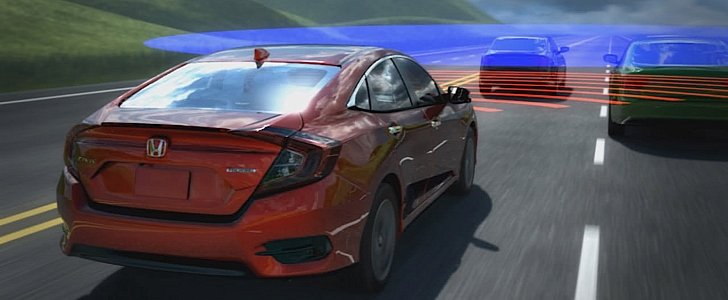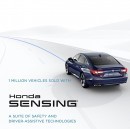Honda’s driver assistance suite, called Sensing, will be standard on all models of the Japanese automaker starting 2022.
The decision was made as a result of findings from both the Insurance Institute for Highway Safety (IIHS) and Highway Loss Data Institute (HLDI) that shows a reduction in claim rates for Hondas equipped with this suite.
Honda says that for the 2018 model year, 69 percent of the cars sold already have Sensing fitted. The Japanese also plan to make automatic emergency braking available across 95 percent of its fleet two years ahead of the industry-wide voluntary commitment, in 2020.
"Honda dreams of a collision-free mobile society, and the Honda Sensing technology has a crucial role to play in advancing us toward that goal," said Henio Arcangeli, American Honda vice-president.
"With the rapidly growing population of Honda vehicles applying these technologies, we hope to significantly reduce collisions involving Honda vehicles within the next three to four years."
Honda’s Sensing suite includes additional safety features and driver assistance technologies ranging from collision mitigation to lane keeping assist. For now, it is standard on several of the carmaker’s models, including the Clarity and the Accord.
In March 2016, the National Highway Traffic Safety Administration announced it has agreed with 20 automakers, representing more than 99 percent of the U.S. auto market, to make automatic emergency braking a standard feature on virtually all new cars by 2022.
The call for the implementation of such a system arises from the necessity to reduce the number of injuries and expenses caused by low-speed impacts. Studies have shown that even if a crash is not entirely avoided, it is likely the striking vehicle at least slowed before the crash by such systems.
IIHS data regarding Honda vehicles equipped with the Sensing suite shows an 11 percent drop in property claims and a 28 percent decrease in injuries to people in other vehicles or pedestrians.
Honda says that for the 2018 model year, 69 percent of the cars sold already have Sensing fitted. The Japanese also plan to make automatic emergency braking available across 95 percent of its fleet two years ahead of the industry-wide voluntary commitment, in 2020.
"Honda dreams of a collision-free mobile society, and the Honda Sensing technology has a crucial role to play in advancing us toward that goal," said Henio Arcangeli, American Honda vice-president.
"With the rapidly growing population of Honda vehicles applying these technologies, we hope to significantly reduce collisions involving Honda vehicles within the next three to four years."
Honda’s Sensing suite includes additional safety features and driver assistance technologies ranging from collision mitigation to lane keeping assist. For now, it is standard on several of the carmaker’s models, including the Clarity and the Accord.
In March 2016, the National Highway Traffic Safety Administration announced it has agreed with 20 automakers, representing more than 99 percent of the U.S. auto market, to make automatic emergency braking a standard feature on virtually all new cars by 2022.
The call for the implementation of such a system arises from the necessity to reduce the number of injuries and expenses caused by low-speed impacts. Studies have shown that even if a crash is not entirely avoided, it is likely the striking vehicle at least slowed before the crash by such systems.
IIHS data regarding Honda vehicles equipped with the Sensing suite shows an 11 percent drop in property claims and a 28 percent decrease in injuries to people in other vehicles or pedestrians.










